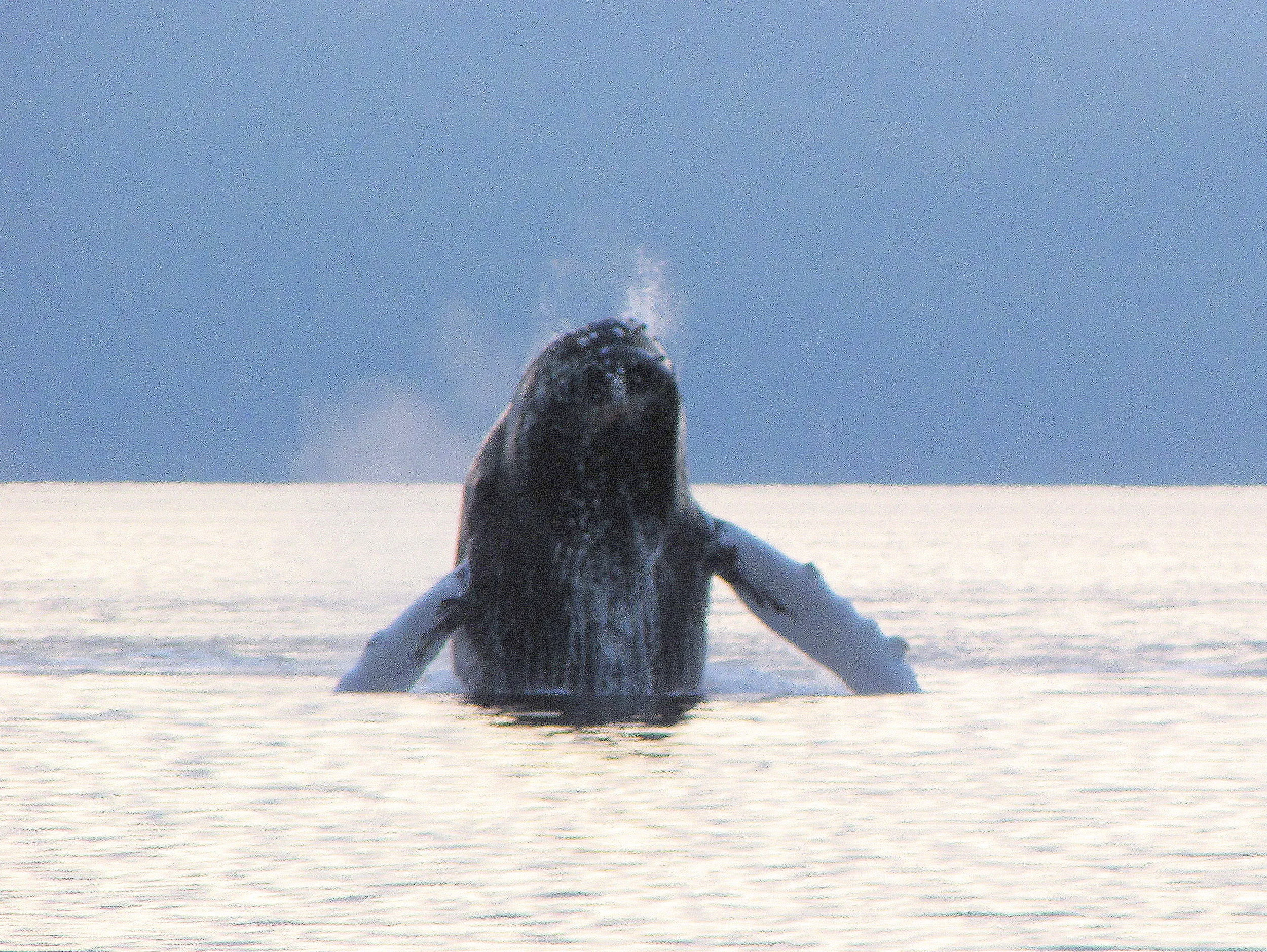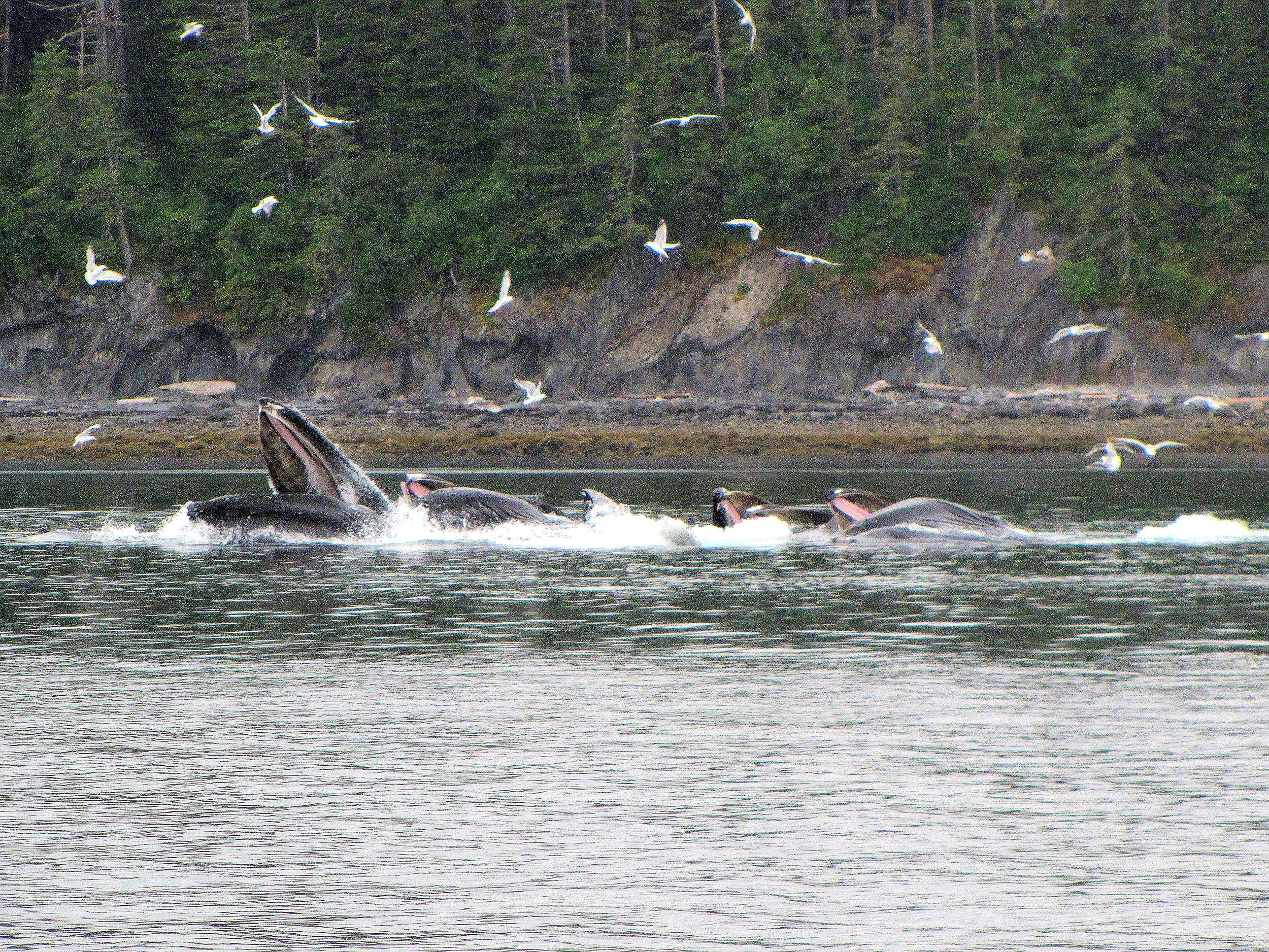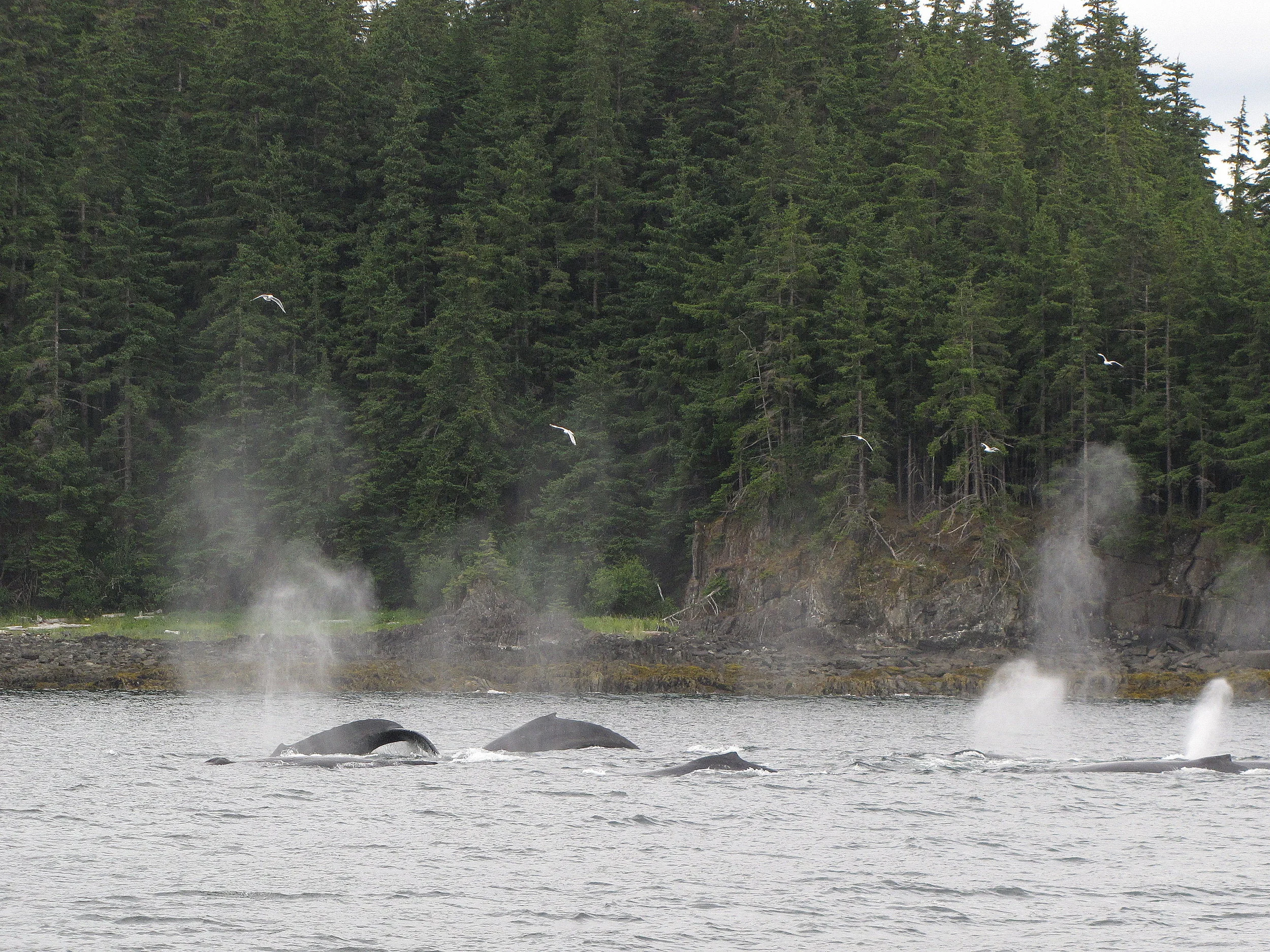The Show-Off Cetacean
Text by Liz McKenzie and Photos by Richard Nelson
The Show-Off Cetacean
As whales go, humpbacks aren't the biggest—a "mere" 40-45 feet long compared to 60 foot sperm whales and 100 foot blue whales—the biggest animal that has ever lived. But humpbacks are arguably the best loved and they're definitely the biggest show offs of all the cetaceans.
No other whale puts on so many spectacular acrobatic performances. Humpbacks are known for their leaps—enormous bodies bursting up into the air and crashing down in massive eruptions of spray. They also seem to enjoy lobtailing—an explosive crashing of their tails on the surface—and they often exuberantly slap the water with their great wing like flippers.
Humpback whales are also famous for their highly choreographed bubble net feeding—10 to 12 gaping mouths bursting through the surface at once. In all these ways, humpback whales put on an awe-inspiring show that thrills first time whale watchers and seasoned research biologists alike.
There is simply nothing like watching these 40-50 ton animals go through their paces. And that's just what we can see from the surface. There's much more to a humpback whale's life story going on underwater, and it's just as fascinating as what's happening at the surface.
An Enormous Beauty
What humpback whale watchers usually see is the animal's broad, dark, shimmering back and the streamlined dorsal fin slicing through the water, or they might only spot the animal's telltale misty blow rising in the distance.
But if viewers are lucky, they might see the enormous breadth of this beauty, all 40 to 45 feet of stout whale, torpedoing out of the water, spinning around, and then slamming full length against the water, with the accompanying blast of spray in all directions. This is called breaching…and biologists are not sure why the whales do it.
Of course, it's easy to imagine that whales might just breach for the pure joy of being airborne and creating that tremendous splash.
The front flippers on these animals are also impressive, up to 15 feet long. They're often seen slapping against the water, or extended languidly above the surface…as if the whale simply likes to feel the air.
When a humpback whale makes a dive, spectators often get to see the flukes or tail, which is comprised of a narrow stock and two wide blades totaling up to 18 feet across. The sight of the flukes rising gracefully above the water, seeming to pause momentarily with waterfalls cascading down, is so beautiful that often a boatful of whale watchers lets out a collective gasp or breaks into applause.
And then the show is over, at least for a while... humpback whales can stay underwater as long as 30 minutes and can dive to nearly 500 feet; but most dives are shorter and in shallower water because that is where the whale's prey is found.
The bottom side of a humpback whale's flukes ranges from pure black to pure white, but most often it's a patchwork of splotches—and the pattern of these marks is unique to each animal.
Biologists use these patterns like fingerprints to identify individual whales. University of Alaska whale biologist Jan Straley has been studying humpback whales in Southeast Alaska since 1979. To aid in identifying whales for research, she and her colleagues have compiled an impressive number of fluke photographs—a Who's Who of humpback whales inhabiting this stretch of the North Pacific coast.
All the World's Oceans
Humpback whales have one of the longest migrations of any mammal on earth—up to 6,000 miles round trip from their summer feeding areas in the far north to their winter mating and calving grounds in the subtropical Pacific. The fastest documented migration time for a humpback whale was an animal identified by Jan Straley and her colleagues in Southeastern Alaska and then spotted 2,500 miles away in Hawaii just 36 days later.
Humpbacks are found in all the world's oceans. Biologists differentiate populations depending on where the animals spend their summers and winters. In the Atlantic, whales summer in shallow waters above the continental shelf off the eastern coast of Canada and the United States. This population winters in the Caribbean.
The largest numbers of humpback whales feed in the rich waters of the Antarctic in summer, and then spend the winter in warm seas off Australia, New Zealand, South Africa and South America.
There are three populations in the North Pacific Ocean. The "California/ Oregon/ Washington stock" winters off the coasts of Central America and Mexico and spends the summer feeding from California up to Southern British Columbia.
The "Central North Pacific" group winters in Hawaii and returns to feed off the coasts of British Columbia and Southeast Alaska, and from Prince William Sound to Kodiak.
And the "Western North Pacific" population spends the winter near Japan and is thought to summer in the Bering Sea and around the Aleutian Islands of Alaska.
While most North Pacific humpback whales migrate to warmer places, a few actually stay in Alaska for the winter.
As northern waters warm due to climate change, conditions are becoming more favorable to humpback whales. In fact, in recent times humpback whales have been documented in the Beaufort and Chukchi Seas off the arctic coast of Alaska.
Northern waters are rich with marine life, providing abundant food for these huge animals. By contrast, there is almost no feed in the tropical and subtropical waters where these whales mate and give birth, so they basically fast during their time in the lower latitudes and the feeding grounds are key to their survival.
Why don't humpback whales just stay in the higher latitudes and feed all year 'round? Biologists don't know for sure, but perhaps the newborn whales must have warmer water to survive, nurse, and grow strong enough to make the long northward migration with their mothers. Or it could be that warm, relatively shallow waters are somehow essential for mating.
Dinner is Served
There are two main groups of whales. The toothed whales—including killer, beaked, pilot, and sperm whales—hunt for prey like fish, giant squid, and marine mammals. Humpbacks belong to the other grouping, called baleen whales, which also includes grey, right, blue and bowhead whales. Baleen whales feed on small schooling fish like herring or on swarms of tiny shrimplike crustaceans called krill. Their throats are expandable, like an accordion, so these whales can take in huge amounts of water along with their prey. Then the whales uses their tongues to force out the water through slats of baleen, which trap the food, like the teeth on a comb.
During the rich summer months, humpback whales must eat as much as possible, up to a ton of food every day. The thick layer of blubber that they put on during the summer and fall must sustain them through several foodless winter months in the sterile blue waters of their mating and calving grounds.
Humpback whales use several different feeding strategies. One technique is for a whale simply to open its mouth while it swims through a dense school of fish or krill. To use another method, the whale faces straight down in the water with its tail at the surface, then lobs or slaps or slashes its tail against the water. This action concentrates the fish, so the whale can then come up under the swarm, mouth open and scoop in its dinner.
Perhaps the most impressive of all is bubble net feeding. This is a remarkable, highly specialized technique, and the only whales in the world that use it for group feeding are humpbacks in Southeast Alaska and British Columbia.
Normally these whales are solitary feeders, but this unique cooperative hunting method often brings together groups of two to ten or more, working in a choreographed sequence.
First the whales swim around the fish to crowd them together. Then one whale, usually the same individual each time, starts under the swarm of fish and swims upward in a spiraling circle, while it also exhales bubbles through its blowhole. A wall of silvery, shimmering bubbles surrounds the fish or krill like a net, tightly concentrating the prey against the water's surface.
All of the other whales in the group surge up inside the bubble net, then open their mouths to take in the panicked fish. During this process, one whale makes an otherworldly high-pitched feeding call—loud enough so that people nearby sometimes hear it in the open air or through the bottom of their boat. Biologists say that the singer is usually the same whale each time as well. Listen to bubble net feeding calls recorded by researcher Jan Straley. *
Love Songs of the Sea
Humpback whales migrate huge distances to gather each year in warm tropical and subtropical areas. For a female who became pregnant the previous year this is the time to give birth. As soon as her calf is born, the mother nudges it to the surface for its first breath, after which the little whale begins swimming on its own.
The calf is very small—by the gargantuan standards of whales—weighing about 2 tons and measuring 12 feet long. Like all mammals, the little one suckles milk, from mammary glands on the mother's underside, and biologists estimate that she can produce over 100 gallons of milk each day, with about a 55 percent fat content (compared to about 3.5 percent for whole cow's milk). When they're weaned six months to a year later, the young whales have grown to about 10 tons and 27 feet long.
The humpback calf is playful and curious. It might frolic with passing dolphins, play with floating sticks, or swim next to a boat and check out the amazed watchers. Calves also mimic adult behaviors like tail slapping and bubble streaming, and they sometimes do what might be called "binge breaching"—leaping from the water again and again, as if they can't contain their childlike energy.
Winter is also the time when males sing intricate songs lasting up to 20 minutes…one of the most complex, fascinating, and beautiful sounds produced by any animal. The song carries up to 20 miles underwater, and it is interesting to realize that whale calves are born into a warm blue ocean filled with these ethereal sounds. Listen to a humpback whale singing recorded by researcher Jan Straley.*
Birthing time is also the season when male humpback whales are looking for love. Biologists cannot say for sure if the songs are part of courtship. Some singing begins in the fall before migration, but most of these remarkable operatic performances are heard during the mating season.
Males are very aggressive towards other males during this time. They chase each other, engage in bubble-blowing displays and tail thrashing, and sometimes they even hit each other with their tail, head, or body.
In the spring, the whales begin to head towards their summer feeding grounds, but not everyone leaves at once. First the pregnant females start out—this gives them the most time to feed when they arrive in the north. Next the young whales leave, followed by adult males and non-breeding females, and finally the mothers and calves—a late departure that allows the calves the most time to grow before making a prolonged, strenuous and dangerous journey.
No one is certain how long humpbacks live, but it's thought to be between 30 and 40 years, with some elders living 70 years or more.
Back from the Brink
We don't know how many humpback whales plied the shallow coastal waters and deep ocean migration routes before commercial whaling, but it's clear that overhunting brought them very close to extinction.
Beginning in the 1800's and up into the 1960's, whales were hunted without regard to the decimation of the species. Whales were used for their meat; the blubber was rendered to produce oil for lubricants, candles, and lamps; and the baleen was used for making corset stays, collar stiffeners, buggy whips, and parasol ribs.
Before 1905, it is estimated that in all of the North Pacific Ocean, there were 15,000 humpback whales and by 1966, the population had plummeted to between 1,000 and 1,200 individuals.
The first efforts to protect humpback whales came in 1946 when the International Whaling Commission (IWC) was established and began to regulate harvests of whales in the North Atlantic Ocean. In 1955, all commercial hunting of humpback whales was banned there, and in 1965, humpback whale populations in the Pacific Ocean finally gained protection from commercial whaling, although Soviet ships continued taking whales until 1980.
Since the 1970's, humpback whales have been protected under U.S. law by the Endangered Species Act and the Marine Mammal Protection Act.
While humpback whale numbers have increased—the North Pacific population is estimated to be 18,000-20,000—there are still serious threats to the well being of these animals.
Maritime vessel strikes and entanglement in fishing lines take a toll on whales every year. Other threats include oil spills; chemical pollutants, which have been found in whale blubber; noise disturbance from explosives, ships, oilrigs, and other activities; and changes in prey species due to climate change, overfishing, and other human impacts. There is still some illegal taking of whales and some countries would like to resume commercial humpback harvesting, which could happen if these whales are removed from the U.S. endangered species list or with changes in the IWC regulations.
It's worth remembering that a new commercial industry—humpback whale watching—has grown up in many parts of the world. And so these extraordinary animals remain economically important for many communities along the coasts of Mexico, the mainland U.S., Canada, Alaska, and Hawaii, as well as other Pacific Islands and countries like Australia.
For anyone who has felt the pure joy of seeing a humpback whale breech, has watched the graceful arc of a fluke rising out of the water, or has heard the haunting and ancient songs of these great animals, the preventable loss of even one humpback whale is a heartbreaking thought. Wherever humpback whales are found, people will come to watch their acrobatic breaches, to hear their powerful blows and mystical voices, to watch their great gleaming backs rise and roll, and to imagine their great bodies gliding silently in the unseen depths.
* Humpback whale recordings were authorized under NOAA scientific research permit 14122 to Janice Straley.









